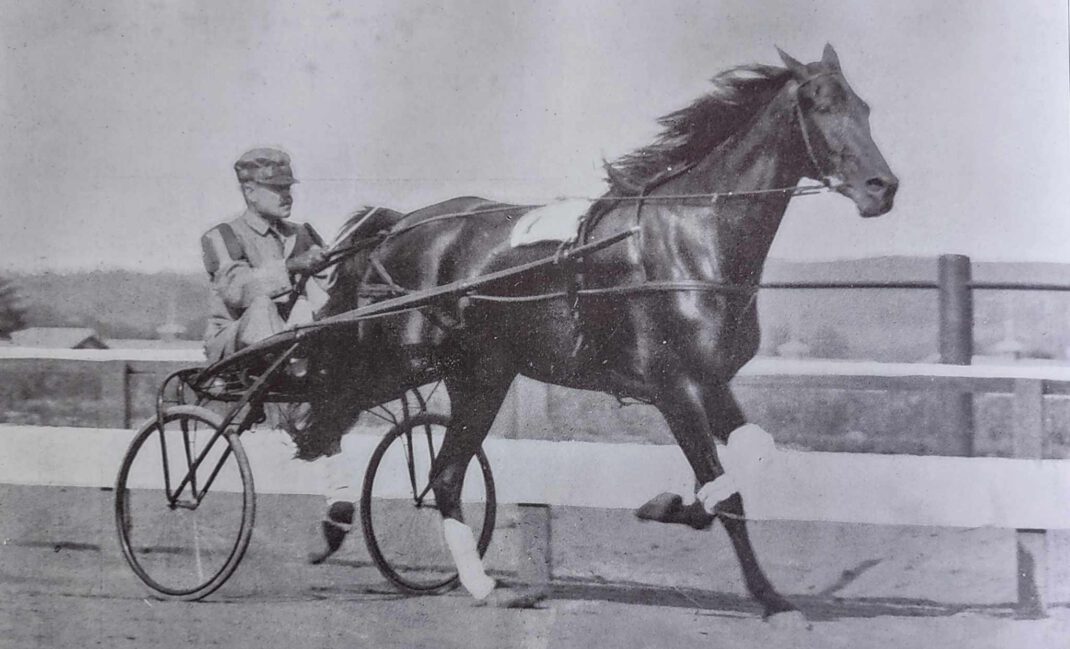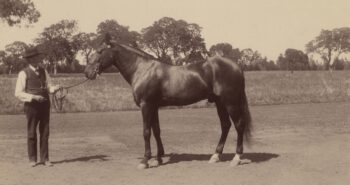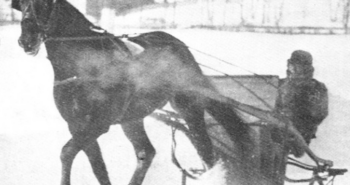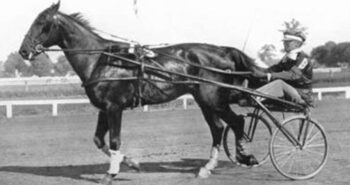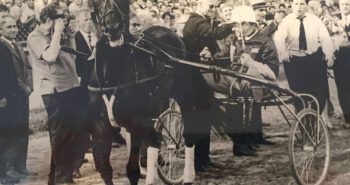Widely expected to be one of the first 2:00 trotters, Axworthy’s most spectacular daughter was nearly invincible at her best. The fastest mare in history at that point, she passed early and has largely slipped into oblivion. Hamburg Belle’s legacy deserves much better, however.
Sallie Simmons (often referred to as “Sally Simmons”) had shown tremendous speed in her time. At 2 her owners, who had bought the mare from breeder George Agniel in Princeton, IN, had spent all season trying to break her to no avail. According to one newspaper, the following year Bert Shank was hired as a trainer by the Rumbargers and according to the Indianapolis News, “he conquered the fast filly and made her what she is, but it was not until after he had received many hard knocks. Shank was possessed of about as much obstinacy as the filly, and Sallie soon took a sensible view of this fact.”
With that out of the way, Sallie Simmons was all trot and became “one of the best behaved campaigners on the Grand Circuit” as a four-year-old in 1894. After she had beat Roseleaf in the 2:20 four-year-old trot at Rochester on Aug 15, the latter’s owner Major Samuel T Dickinson shelled out $7,500 to acquire Sallie Simmons. He then had a formidable pair of four-year-old mares, and on Sep 27 the duo set a team world record to wagon, trotting in 2:15 1/4 (1.24,1) at Columbus. On her own, Sallie Simmons trotted to a very respectable 2:13 1/4 (1.22,8) clocking in one of her many wins that year. Not racing on the Grand Circuit after the 1894 season, Dickinson nevertheless “drove Sallie Simmons a half in Fleetwood at 1:06 1/2” shortly before his death in late 1896. She was then sold by Dickinson’s estate to Edward T Bedford, an early executive for Standard Oil, for $3,500 and used as a roadster in team with Gillette 2 11 3/4 (1.21,9). The pair broke the record for a road wagon on a half-mile track when going 2:21 (1.27,6) at the Parkway Driving Club in Brooklyn on May 15, 1897.
Selecting a stallion
After using Sallie as a roadster for a few years, she entered the breeding shed but started off that with two aborted foals by Quartermaster, a son of Alcyone. WW Shuitt, superintendent of the nearby Parkville farm, would later tell the Boston Globe how it came to be that the mare was sent to his suggested stallion, then relatively unknown Axworthy: “Mr Bedford, being a resident of Brooklyn and an enthusiastic road driver, frequently paid a visit to the Parkville farm, and on those occasions usually allowed whatever horse or team he chanced to be driving, to step a fast quarter or half, and occasionally a mile, over the farm track, and especially enjoyed the outing when he could find some one to step along with him. Mr Shuitt had on different occasions told him about Axworthy and had intimated that he would like very much to have Mr Bedford breed Sallie Simmons to him, but the latter held back, and had, at that time, decided to breed her to a stallion up near his farm in Connecticut.
He had never seen Axworthy, who was at that time 9 years old, but looked like a colt, so one morning while Mr Shuitt was jogging him, the owner of Sallie Simmons drove in on the track with a pair of trotters, one of which was the fast gelding York Boy 2:08 3/4 (1.20,0). He jogged up alongside or Mr Suitt and asked what the youngster was and, just for fun, Shuitt told him that it was a 3-year-old son of Axworthy.
After they had jogged along together, both men allowed their animals to increase their speed, which wound up with a race through the stretch, and the supposed youngster outfooted the pair and incidentally trotter a quarter in the neighborhood of 30 seconds. Mr Bedford at once became enthused over the wonderful performance of the supposed 3-year-old, but Mr Shuitt could not carry the joke further, and informed his visitor that the “colt” was none other than Axworthy.
Mr Bedford had seen enough to know that Axworthy was a great natural trotter, and at once decided to send Sallie Simmons down to be bred by him.”
A talented filly
Sallie Simmons was sent to Hamburg Place in January 1902 and three months later a filly saw the light of day. Bedford avoided any and all attempts at creativity and simply named her “Sallie Simmons II”. It would be the only foal from the great mare: in Kentucky she was bred to Arion but that following winter, within two months of foaling, she slipped on the ice, broke both her hind legs and had to be euthanized. Bedford took Sallie Simmons II home as a yearling, and she was broke and given her early education at Bedford’s Wynfromere at Green Farms, CT by his daughter Emily. In an article in the Courier-Journal on Sep 6, 1909, Emily Bedford was described as “the most expert all-around horsewoman in America, if not the world.”
She clearly did a good job on the filly, because Sallie Simmons II showed talent early. From the Courier-Journal, At 3, “Mr Bedford, who is an experienced reinsman, drove the young mare a half in 1:08 1/2, last quarter in 32 seconds, to a cart, over the half-mile course at the farm.” In the hands of Bob Williams, trainer of Bedford’s stable, the four-year-old Sallie Simmons II won all three engagements in straight heats. The following year she started twice, winning at Danbury, CT and losing at Mineola despite taking two heats and seting a 2:12 3/4 (1.22,5) record on the half-mile track.
Bedford had earlier sold half of Sallie Simmons II to John Madden. The latter “who saw the mare perform now and then, became satisfied she had the making of a great trotter. So after the campaign was over he went to Mr Bedford and told him frankly just what he thought. Also he added that one of them ought to own the mare instead of having her a partnership affair. Would Mr Bedford set a price on his half? Mr Bedford did, and Madden wrote a check right there, saying he considered her cheap at the price, whereat the partners separated, each tickled to death.” Madden paid $5,000, valuing the mare at $10,000. Though it was a lot of money, it would turn out to be a steal.
Hitting the Grand Circuit
Madden immediately sent her to trainer Billy Andrews, and when the mare stepped onto the track at Detroit the following July. Then her name had been changed to Hamburg Belle, both for Madden’s famed nursery Hamburg Place in Kentucky, and also for his great thoroughbred filly Hamburg Belle, winner of the Futurity Stakes. Hamburg Belle was immediately at home on the bigger and faster tracks and quickly immediately established herself as one of the very best on the Grand Circuit. Winning the 2:10 trot at Detroit on Jul 29, 1908, she took the first heat in an impressive 2:05 1/4 (1.17,8). She duplicated that time and set a track record in Kalamazoo the following week. In Poughkeepsie on Aug 19, it was another track record as Hamburg Belle defeated Spanish Queen and swept the Oakland Baron Stake in three straight heats, winning in 2:05 1/4, 2:07 and 2:07 (1.17,8, 1.18,9 and 1.18,9). In the first heat, Hamburg Belle rushed to the lead and reached the half in 33 seconds. With Spanish Queen outside, the pair went down to the half in 1:01 3/4, a second quarter in 28 3/4, a 1:55 (1.11,5) clip – completely unheard of back then. The Ponkapoag Trot at Readville, at the end of August, was then “a walkover for John Madden’s mare”, winning in 2:06 1/2, 2:06 1/2 and 2:06 1/4 (1.18,6, 1.18,6 and 1.18,5).
Going to Hartford for the $10,000 Charter Oak Stake, Hamburg Belle kept up her winning ways, taking home the three heats in 2:05, 2:06 and 2:05 3/4 (1.17,7, 1.18,3, 1.18,2), a new three-heat world record. “No other entry had a chance against the fleet-footed mare, which ran like a machine, steady and true, all the distance. Her only real opponent was Locust Jack, but he at his best was but a poor second.” Interestingly enough, each of Hamburg Belle’s three winning times were below the 2:07 1/2 (1.19,2) track record previously held by Georgena. Hamburg Belle’s performance was all the more impressive given that Hartford was widely known to be a slow track.
After the impressive win, famous harness journalist Henry Ten Eyck White wrote “on the occasions I have seen Hamburg Belle trot a quarter in :30 and with the sole exception of Lou Dillon no other trotter ever maintained that rate of speed with such apparent ease. When the mare won at Detroit I called attention to her in this column and said she was the classiest looking trotter of the season by long odds. As Jack Leyburn had only two weeks previous put up a new three heat race record, there was considerable criticism of this estimate of the mare, some of it coming from people who had a right to know about such matters.
One of that class on the day the Charter Oak was trotted, called my attention to my estimate of more than a month ago and said that in the Connecticut race, for the first time there would be a chance for a fair test of Hamburg Belle’s alleged greatness. ‘She meets a new class of horses this trip’ was the talk. ‘and Jack Leyburn is one of them. He never went a bad race in his life. He has the record for three heats, and he will snow her.’
But he didn’t. On the contrary, the second horse in each of the three breaking heats was Locust Jack, which has a record around 2:08 and never has been pegged as belonging in the Hamburg Belle or Jack Leyburn class. But he had McHenry for his driver, and that means so much it is hard to put the percentage high enough.”
Hamburg Belle picked up a slight injury at Hartford, causing the mare to skip the Transylvania Trot at Lexington in October, the daughter of Axworthy being laid over till the next season. The five 1908 Grand Circuit wins netted Madden, who had passed ownership of the mare to his two sons, $12,100. A huge number, but still way behind Allen Winter’s $30,600 courtesy of his win in the American Trotting Derby at Readville. At the end of the season, Hamburg Belle’s trainer Andrews stated his regret not to have started the mare in that race at Readville – and in fairness it’s hard to see how anybody could have beat her.
World records
In November 1908, newspapers reported that John Madden “is thinking of sending Hamburg Belle across the water for a campaign over the tracks of Austria”, that being where the best European trotters were found prior to WWI. However, the fantastic mare stayed in the US, and Madden and trainer Andrews had their sights set on one clear goal in 1909: “WJ Andrews, who will campaign the Madden stable this year, has written that he expects to see Hamburg Belle eclipse the record of Lou Dillon this year, as she has so far shown halves and quarters better than a two-minute gait, and he regards her as one of the greatest light harness horses this world has ever seen. It would have been an easy matter for the Madden boys to have sold Hamburg Belle last fall to foreign buyers for the greatest price ever paid for an American-bred trotting mare, but as it has been their purpose ever since they became the owner of the daughter of Axworthy to ultimately place her in the stud at their breeding farm in this country several handsome offers were refused for her.”
The speedy mare started the 1909 campaign in impeccable fashion, time trialing in 2:02 3/4 (1.16,3) at Detroit on Jul 30, 1909, the four quarters trotted in 30 1/2, 31, 30 1/4 and 31 seconds. She failed in an attempt to lower this at North Randall the following week, finishing in 2:03 1/4 (1.16,6).
Defeating Uhlan
Staying at the new track in Cleveland, it was decided that Hamburg Belle and Uhlan would meet in two or three match races “for trotting supremacy” They first met in a match race on Aug 25, 1909. The mare brushed aside the gelding in two straight heats and set five new world records: fastest race, beating Cresceus’ old 2:03 1/4 record by a full two seconds (!); fastest half in a race with 59 1/2, set in the second heat, a full second faster than The Monk five years prior; fastest heat by a mare previously being Sweet Marie’s 2:03 3/4 (1.16,9); fastest second heat, also Sweet Marie’s 2:03 3/4 (1.16,9) and finally fastest two heats, also a record taken from Sweet Marie, who previously had trotted in 2:04 3/4 and 2:03 3/4 (1.17,5 and 1.16,9).
In the first heat “Hamburg Belle drew the pole and got away with a heat advantage at the start. The bay mare drew away from Uhlan until she was a length ahead at the quarter pole; Uhlan showed a remarkable burst of speed in the next quarter, forcing Hamburg Belle to use every bit of her strength to prevent him from going ahead of her.
The bay mare led by less than a head when the half mile post was reached in 1:01. Down the track and horses sped to the three-quarter in 1:31 and when they headed into the home stretch they were neck and neck. Hamburg Belle appeared to be tiring and a mighty shout “Uhlan wins!” went up from many parts of the grand stand. Driver Proctor urged Uhlan to exert himself to his best and for a moment it seemed that he would race under the wire a winner. The driver Andrews, behind Hamburg Belle, waved his whip sharply above the back of the lagging mare. As if electrified by the swish of the whip, Hamburg Belle took on new courage and pushed steadily down the course away from Uhlan, winning by a head and establishing the new mark of 2:01 1/4 (1.15,4).
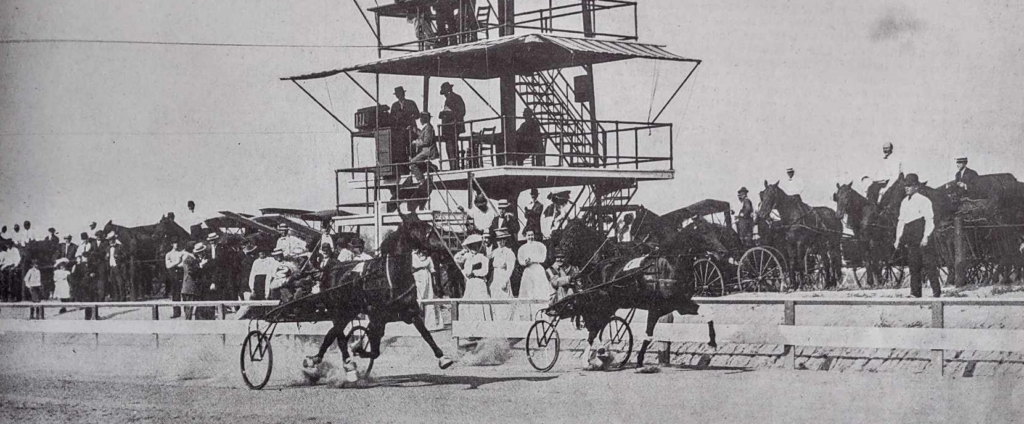
In the second heat Hamburg Belle got away a neck ahead and lengthened her lead to a length in the first quarter, which she made in 30 1/2. Uhlan spurted at the turn, but a few feet from the half mile pole a quarter boot slipped down, causing him to break. After losing 100 yards, driver Proctor got the horse on his feet, when the boot slipped further down, caught in Uhlan’s shoe and pulled it off, causing the horse to come limping home distances and defeated.” Hamburg Belle thus coasted to an easy 2:01 3/4 (1.15,7) win in the second heat.
Madden wasn’t the celebrating owner after the second heat, though. Immediately after the first heat, Hamburg Belle had been sold to Cleveland businessman and millionaire Howard Melville “Mel” Hanna for $50,000. A brother of US senator Mark Hanna, known as the “President-maker” as he backed both Garfield and McKinley and conducted both presidential election campaigns of the latter, it was reported that the new owner “will permit the mare to finish her season, including the series of races of two best in three between the mare and Uhlan.” After that, however, Hamburg Belle was to be used in the matinees of the Gentleman’s Driving Club of Cleveland.
The rematch
Famed harness journalist Tom Gahagan simply wrote that “experts no longer question supremacy of Hamburg Belle”, but many also warned that Uhlan could very well turn the tables around in their second meeting at Readville at the beginning of September. This is indeed what happened. In the first heat at Readville, “immediately Andrews opened a gap of a length, maintaining this advantage clear to the three-quarter pole, when it was seen Proctor was driving for the first time in earnest in attempting to overtake Hamburg Belle. Rapidly he closed in on the mare until at the head of the home stretch he had his head at her saddle. Andrews apparently had confidence in the finishing ability of Hamburg Belle and never made a move until he saw Uhlan had reached her neck. Then, thirty yards from the wire, he tapped the trotting queen a couple of times, but failed to get a response, and Uhlan quickly went into the lead, winning easily by two lengths.” There was a reason for this, though, as the mare’s knee boot had slipped down about her foot, which clearly bothered her.
The second heat started more or less like the first one. “Andrews, knowing the result of waiting possibly too long in the former mile, was not to be caught so easily this time, and he began when entering the stretch to tease his mare for increased speed. However, Uhlan was as certainly crawling to even terms and had collared his opponent when inside the distance. There Andrews was successful for a number of yards in holding his own, but soon after it was perceptible to the spectators that Hamburg Belle was weakening under the train. Cheering began all along the quarter stretch for the conquering horse, which then came away in front and was a good length in front at the wire.” The winning times were 2:04 3/4 and 2:03 1/2 (1.17,5 and 1.16,8) on a track seen as “fully two seconds slower than when the great Lou Dillon startled the world with a mile in two minutes here.”
It was the decided that Hamburg Belle and Uhlan would meet at Columbus at the end of September to settle their rivalry in a third and final match race. At first, Andrews took her to Syracuse for another attempt against time on Sep 15. She failed to better her earlier record, but still put in an excellent performance. “Hamburg Belle did not come within three seconds of 2:01, but she went a great mile, everything considered. The time was 2:04 1/4 (1.17,2), but this does not tell the story. Hamburg Belle had her speed – twominute speed – yesterday, and with a fast track she would have been able to carry the clip for a mile. She went to the quarter of a track that had not dried out from a heavy rain in 29 3/4. The next quarter she reeled off in :30 1/2. On the great mare went at very nearly as fast a clip, she getting to the three-quarters at 1:31 1/4. Here the sticky going began to tell. The legs of the great mare had been put under a great strain, greater by far than at Cleveland. Andrews called up on her in the stretch and she responded with all her remaining strength, but the best it gave was a quarter in :33, the mile being in 2:04 1/4 (1.17,2).
Hamburg Belle was sent yesterday because she had been advertised to go on that day. Commissioner Settle preferred to lose the chance of getting a world’s record rather than disappoint the thousands who went to the fair yesterday to see Hamburg Belle go. Nobody expected her to come anywhere near her mark. The track did not dry out sufficiently to permit of the starting of the regular races until 4 o’clock. When Hamburg Belle went at 5:15 o’clock, the track was at least three seconds slower than on the previous day.”
The match race against Uhlan was postponed to the Lexington meet in October, but ended up being cancelled as the mare struggled with lameness after the Syracuse effort, “the knee of the right foreleg of the mare has so swollen that trainer Andrews has not been able to turn her around once on the track.”
Tragedy
Shortly after that, tragedy struck. On Nov 10, 1909, Hamburg Belle died at owner Hanna’s farm at Thomasville. She had gotten sick en route and succumbed to pneumonia shortly after arriving in the south. The situation was described in newspapers of the time as “pneumonia of the galloping kind”, which strongly suggests it was pleuropneumonia.
Hamburg Belle was inducted into the Goshen Hall of Fame in 1957. She is buried at the Hamburg Place Horse Cemetery in Lexington.
HAMBURG BELLE
(ex Sallie Simmons II)
Bay mare born in Lexington, KY in Apr 1902. Died in Thomasville, GA on Nov 10, 1909.
Axworthy – Sallie Simmons (Simmons)
2:01 1/4 (1.15,4)
Breeder: Edward T Bedford
Owners: Edward T Bedford – Edward T Bedford and John Madden – John Madden – Howard Melville “Mel” Hanna
Trainers: Bob Williams and Billy Andrews
Drivers: Bob Williams and Billy Andrews
Groom: –

